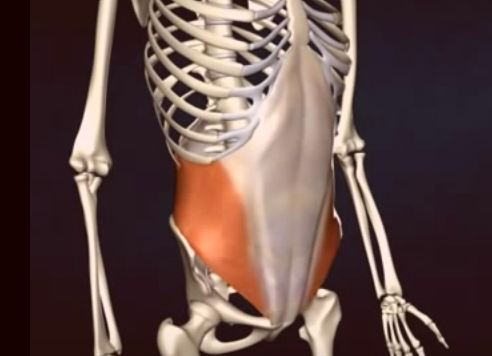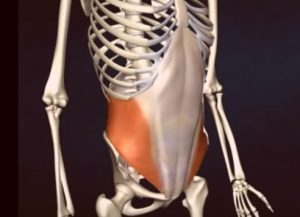In your body, there are 4 abdominal muscles and of those 2 are the oblique muscles. These are divided into internal and external muscles. Obliques are the muscles, which help in many daily activities such as walking, sitting, and standing. The oblique muscles allow you to twist your trunk and bend sideways. They also take part in breathing. These muscles connect with ribs at the top and on their lower end; they connect with your hipbone.
External obliques tend to be larger and are found on the top surface somewhere below the subcutaneous fat within your abdomen. The internal obliques lie underneath the external ones in both side of trunk; therefore, they are deeply located within the body unlike the external obliques.
Sometimes, a strain injury may occur on oblique muscles. The strain injury happens when the muscles are overstretched. At times, they may be partially torn. Such straining of the muscles can be very painful and debilitating. Oblique muscle strains are common in people who are actively involved in strenuous activities or athletes because the muscles tend to be constantly engaged.
Athletes engage oblique and other abdominal muscles in order to tighten their core and enhance performance in sports. When you have straining of oblique muscles, you need to treat the symptoms because if left unchecked, the injury may get worse or it could become chronic.
Causes of oblique muscle strain
Your obliques are more active when you do forward bending, twisting movements, or side bending. A strain of these muscles is mainly preceded by these movements or body activities. People who engage in sports like tennis, golf, and baseball are more susceptible to these kinds of injuries.
Workouts such as high intensity exercises that target abdominals and core muscles including crunches and sit-ups may also be accountable for the strains. Sometimes, something as small as chronic sneezing and coughing could bring about the strain of the obliques. Straining of obliques occurs during activities that make use of these muscles.
You need to remember that the muscles are connecting the lower back, the abdominal fascia, the top part of hipbone, and the ribs. In simple explanation, the obliques are your waist muscles— that is how you can remember them easily. When you suddenly or forcefully bend or twist the body, you may cause pain or strain these muscles.
Similarly when you are involved in direct trauma that affects the abdomen, it may result in straining. Overuse of the muscles is another possible cause. Activities like rowing, lifting heavy tools from the ground, raking soil, having a posture that is slouching, and bowling forcefully when playing cricket are possible causes, which may induce pain or strain on obliques.
Sitting for long periods without having breaks could also cause the muscles to strain. People who have abdominal scars arising from surgery procedures may have straining on the muscles. Activities such as lifting with a shovel or pitchfork could also cause the problem.
Symptoms— what it feels like to have oblique muscle strain?
A person who experiences strain of abdominal oblique muscles will feel pain and encounter stiffness of the muscles. A sharp pain may be felt along the lower chest. The pain may extend to side of abdomen because of sudden or forceful bending and twisting of trunk. Pain happens because the muscle fibers are developing micro tears.
Pain may occur when you try to pull the muscles. At other times, it may occur gradually. It may even be felt when you are at rest. Whenever you have minor strains, the pain tends to worsen when you indulge in certain activities, otherwise; if you are resting or doing moderate activities, you may not have the pain.
The muscles may feel stiff something that happens mainly when you wake up in the morning. Sometimes, the stiffness can restrict your ability to accomplish daily tasks. Where severe straining occurs, there may occur symptoms like swelling, weakness, and bruising on side of the muscles. You may also experience tenderness on the sides or increased pain on the lower chest and abdomen especially when you breathe in deeply, laugh, sneeze, or cough.
Treating oblique muscle strain
It may take up to about 10 weeks or so to treat the strain and pain. When you first experience the strain, you can apply ice on the area to ease pain. You should refrain from activities that may aggravate the sprain or injury and have adequate rest. You may want to take anti-inflammatory drugs to reduce inflammation such as naproxen and ibuprofen but with advice of a doctor.
When the pain begins to subside, you can begin some moderate or mild exercises like stretching or core strengthening — but this should only be done if you are able to tolerate them. Exercising the muscles can help in recovery from the sprain. Massage may also be helpful in treating the strain.

